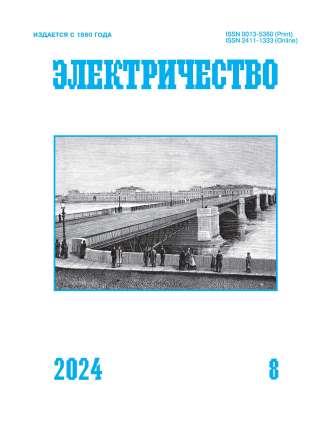The Wear Resistance of the SF6 Circuit Breaker Contact System Composite Materials when Clearing Short-Circuit Currents
DOI:
https://doi.org/10.24160/0013-5380-2024-8-42-49Keywords:
circuit breaker, switching wear resistance, arcing electrode, arc chute, composite material, electric arcAbstract
The article presents the results of experiments on studying the switching wear resistance of the composite materials used in the contact system of 35 kV SF6 circuit breakers during repeated clearing of short-circuit currents of up to 20 kA. Two versions of arc electrodes were considered: when using tungsten-copper (W-Cu) metal-ceramic composite materials with powder components and when using W-Cu electrode materials reinforced with tungsten fibers. For the arc electrodes made on the basis of tungsten-nickel-copper (W-Cu) metal-ceramic composite materials with powder components forming a tungsten-nickel frame impregnated with copper, two cases of components were studied: with a tungsten content of up to 70 and up to 50%. According to the study results, a composite with a tungsten content of 70% was chosen as the recommended one. For tungsten-copper electrode materials reinforced with tungsten fibers, predominant wear of the central part of their working surface and the concentration of the arc basic spot on it were found, which result in that the wear of the fluoroplastic nozzle is by 30-40% lower compared with its wear in the case of using W-Cu electrodes with powder components.
References
2. Учет остаточного ресурса высоковольтных выключателей. ООО «НТЦ «Механотроника». – Электроэнергия. Передача и распределение, 2019, № 3, с.120–121.
3. Smeets R.P.P. Statistical Analysis of Electrical Stresses on High-Voltage Circuit-Breakers in Service Electra. – Proc. CIGRE TF A3. 01 Conference, 2005, pp. 24–26.
4. Carvalho A. et al. Challenges for Managing Overstresses and End of Life of HV Equipment. – Session CIGRE, 2016, report A3-201, pp. 1-13.
5. Шлейфман И.Л. Нормирование коммутационного ресурса выключателей на напряжение 110 кВ и выше в стандартах РФ и стандартах МЭК. – Энергоэксперт, 2015, № 2 (49), с. 36–39.
6. Берент В.А. Эрозия электрических контактов. – Вестник ВНИИЖТ, 2016, т. 75, № 2, с. 88–96.
7. Пинчук М.Э. и др. Особенности эрозии электродов в сильноточных разрядах высокого давления. – Известия высших учебных заведений. Физика, 2014, т. 57, № 12/2, с. 245–249.
8. Смирнов А.П., Хвощан О.В., Жекул В.Г. Эрозия электрода при высоковольтном электрическом разряде в жидкости. – Электронная обработка материалов, 2022, 58 (3), с. 32–23.
9. Агафонов Г.Е. и др. Электрические аппараты высокого напряжения. СПб.: Энергоатомиздат, 2002, 727 с.
10. ГОСТ 1333-83. Контакт-детали металлокерамические на основе вольфрама. Технические условия. М.: Издательство стандартов, 1983, 36 с.
11. Буткевич Г.В. и др. Электрическая эрозия сильноточных контактов и электродов. М.: Энергия, 1978, 256 с.
12. Аракелян В.Г. Физическая химия элегазового электротехнического оборудования. М.: Издательство МЭИ, 2002, 294 с.
13. Минакова Р.В. и др. Влияние SF6 как дугогасящей среды на износ и процессы в рабочем слое сильноточных контактов. – Электрические контакты и электроды: Сб. научных трудов АН УССР, Киев, 1991.
#
1. Nepomnyashchiy V.А. Energoekspert – in Russ. (Energy Expert), 2012, No. 4 (33), pp. 26–39.
2. Elektroenergiya. Peredacha i raspredelenie – in Russ. (Electric Power. Transmission and Distribution), 2019, No. 3, pp.120–121.
3. Smeets R.P.P. Statistical Analysis of Electrical Stresses on High-Voltage Circuit-Breakers in Service Electra. – Proc. CIGRE TF A3. 01 Conference, 2005, pp. 24–26.
4. Carvalho A. et al. Challenges for Managing Overstresses and End of Life of HV Equipment. – Session CIGRE, 2016, report A3-201, pp. 1–13.
5. Shleyfman I.L. Energoekspert – in Russ. (Energy Expert), 2015, No. 2 (49), pp. 36–39.
6. Berent V.А. Vestnik VNIIZHT – in Russ. (Bulletin of VNIIZHT), 2016, vol. 75, No. 2, pp. 88–96.
7. Pinchuk M.E. et al. Izvestiya vysshih uchebnyh zavedeniy. Fizika – in Russ. (News of Higher Educational Institutions. Physics), 2014, vol. 57, No. 12/2, pp. 245–249.
8. Smirnov A.P., Hvoshchan O.V., Zhekul V.G. Elektronnaya obrabotka materialov – in Russ. (Electronic Processing of Materials), 2022, 58 (3), pp. 32–23.
9. Agafonov G.Е. et al. Elektricheskie apparaty vysokogo napryazheniya (High Voltage Electrical Devices). SPb.: Energoatomizdat, 2002, 727 p.
10. GОSТ 1333-83. Kontakt-detali metallokeramicheskie na osnove vol'frama. Tekhnicheskie usloviya (Contact Details are Metal-Ceramic Based on Tungsten. Specification). М.: Izdatel'stvo standartov, 1983, 36 p.
11. Butkevich G.V. et al. Elektricheskaya eroziya sil'notochnyh kontaktov i elektrodov (Electrical Erosion of High-Current Contacts and Electrodes). M.: Energiya, 1978, 256 p.
12. Arakelyan V.G. Fizicheskaya himiya elegazovogo elektrotekhnicheskogo oborudovaniya (Physical Chemistry of Gas-Fired Electrical Equipment). M.: Izdatel'stvo MEI, 2002, 294 p.
13. Minakova R.V. et al. Elektricheskie kontakty i elektrody: Sb. nauchnyh trudov AN USSR – in Russ. (Electrical Contacts and Electrodes: Collection of Scientific Papers of the Academy of Sciences of the Ukrainian SSR), Kiev, 1991




